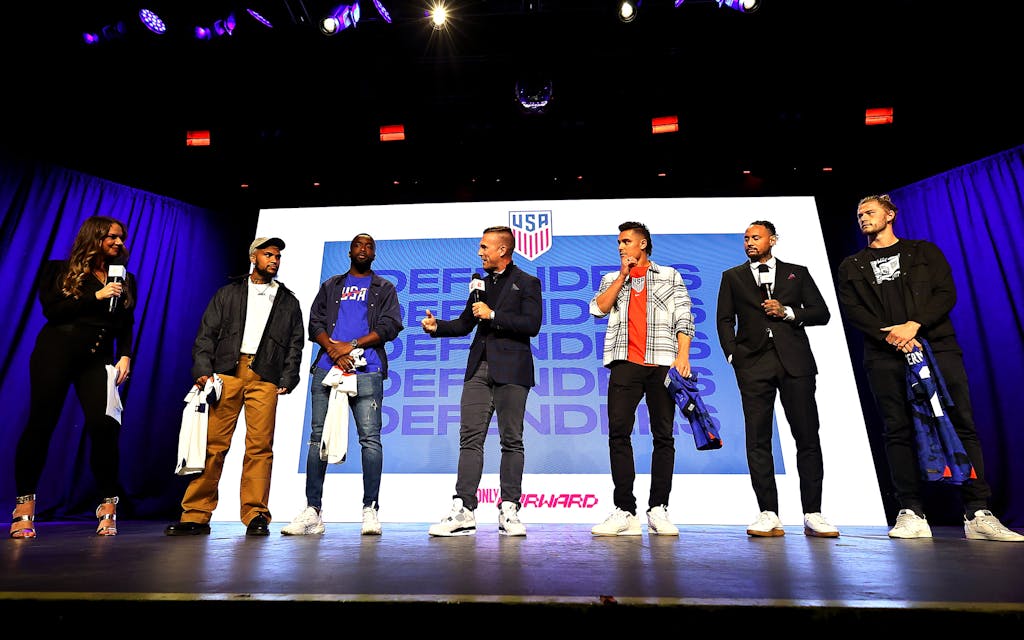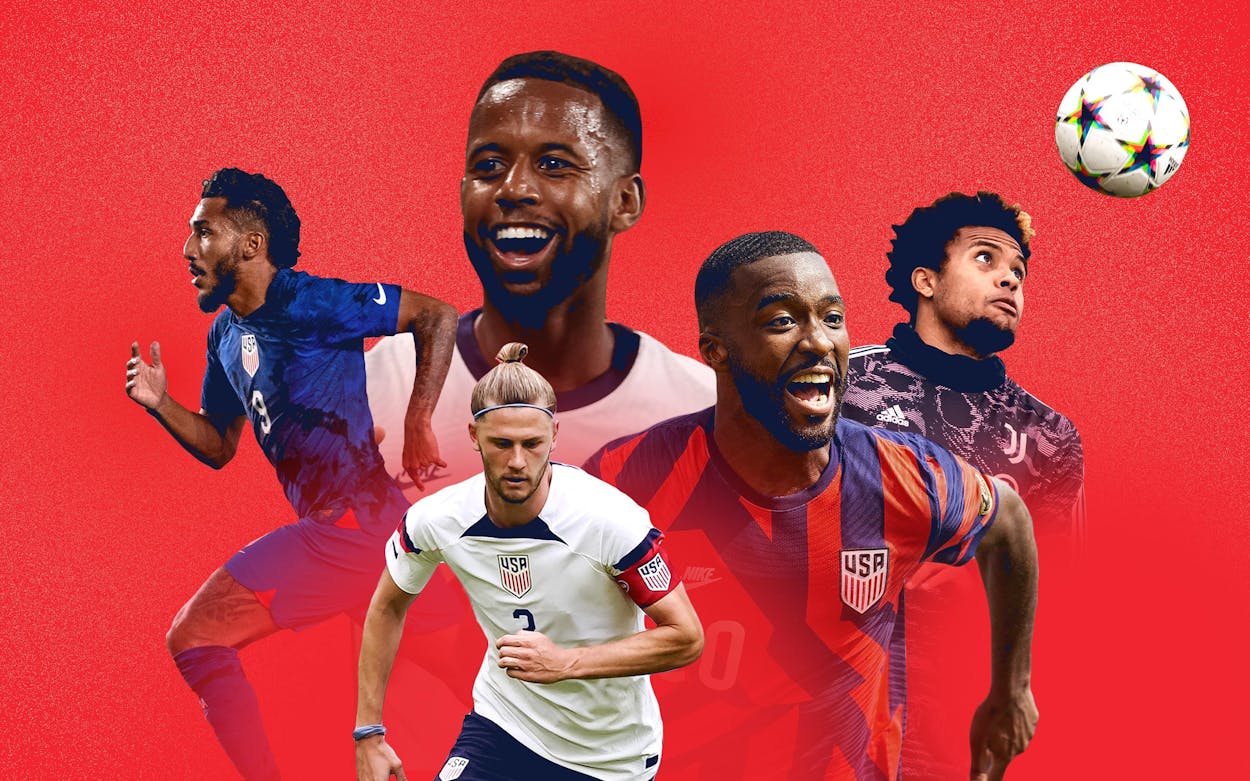Inside a trendy Brooklyn venue in early November, a celebration was underway. Pretty people in pretty clothes hammed it up onstage while a packed room of revelers watched. For the first time in eight years, the United States men’s soccer team had a World Cup roster to announce, and those who made the final cut would be unveiled at this swanky shindig.
Among the 26 players named to head coach Gregg Berhalter’s squad for the 2022 FIFA World Cup, there were both predictable choices and shocking omissions. There were also numerous players with strong Texas ties, more than on any other team in recent U.S. World Cup history.
This year’s World Cup, which began yesterday, is taking place in Qatar, but there will be a distinctly FC Dallas flavor dashed into arguably the largest sporting extravaganza in the world. When it comes to much of the U.S. men’s national team, the road to the Middle East began with a stop in, of all places, Frisco.
USMNT players Jesús Ferreira, Weston McKennie, Walker Zimmerman, Kellyn Acosta, and Shaq Moore all spent time with FC Dallas’s youth academy, its Major League Soccer club, or both. And according to many soccer pundits, the final 26 could (or should) have been even more Frisco-centric. Ricardo Pepi, Reggie Cannon, Chris Richards, and Paul Arriola each had logged plenty of time with the national team in its World Cup qualifying matches. Pepi’s exclusion was arguably the most shocking element of the announcement party. Last September, Pepi became an overnight soccer sensation when he spearheaded a critical victory for Team USA at a time when qualifying for the World Cup was far from a given.
But after Pepi’s headline-grabbing and MLS record–setting $20 million transfer from FC Dallas to FC Augsburg, of the German Bundesliga, the 19-year-old El Paso native failed to make a mark with his new European club, leaving the door open for other American forwards to capture, or recapture, Berhalter’s favor.

That there’s been as much of a furor over who will stay home as who will take the field Monday afternoon, when the United States faces Wales in its first match, is a sign of two things. First, it feels good just to have a team competing in this massive, controversial tournament again. In 2017, a U.S. squad stacked with older players who had already participated in multiple World Cups flamed out, missing out on the 2018 edition in Russia. Second, and more importantly, there’s never been more top-line American soccer talent than there is now. And FC Dallas’s longtime commitment to building up young players goes a long way toward explaining how that talent emerged.
“This isn’t just the result of something in the water in Texas,” Fox soccer analyst Alexi Lalas, a defender on the United States’ 1994 World Cup team, told Texas Monthly prior to the roster announcement. “The Dallas area, specifically, is just teeming with talent, and FC Dallas has leaned into developing that talent really well for many years now.”
A year ago, when Ferreira’s former FC Dallas teammate, Pepi, was dominating the USMNT score sheet, the now-21-year-old forward had barely logged any time with the national team. But in 2022, Ferreira made the most of his opportunities, logging a key goal in a win against Panama in March and scoring a whopping four goals against Grenada on June 10.
The son of 2010 MLS MVP and former Colombian national team midfielder David Ferreira, the McKinney product remembers the disappointment of seeing the United States miss out on the 2018 World Cup. “I wasn’t even thinking about playing on the national team back then,” he said in a recent interview. “Four years ago, I didn’t have any real connection to the U.S. team, and a lot of my love went to the Colombian team that did make the World Cup, which did feel a little weird for me. But now it’s exciting that I’ve helped the U.S. team make sure we didn’t miss out this time.”
Out of 29 MLS teams, what makes FC Dallas’s developmental program stand out? Steve Davis, a television and radio broadcaster for the team and a veteran soccer journalist, told me that’s exactly what rival clubs hope to understand. “That’s the question so, so many academies and academy directors would love to answer,” he said. “FC Dallas has been the standard-bearer, with teams like Philadelphia and maybe Real Salt Lake not far behind. What is their secret sauce? Hard to say, but you can start here: those clubs I just named aren’t afraid to integrate their young players into the top team.”
Ferreira is a product of that vertical integration. He credits the way FC Dallas treats its academy players as professionals from the moment they join the club as a major ingredient in that success. “The first team and the academy teams train at the same facility,” he says. “Our fields are right next to each other. Our locker rooms are right next to each other. The relationship between the academy players and the first-team players is really important to us. When the first team is missing a player, our academy players fill in, so it’s easier to adjust when you go from playing for an academy team to joining the first team.”
The numbers support these assessments from Davis and Ferreira. Since 2009, FC Dallas has been among the MLS leaders in “homegrown” players—athletes a club signs from its academy to the first-team roster. Among current FC Dallas players, Ferreira, Paxton Pomykal, Edwin Cerrillo, and Brandon Servania are all homegrown signees who played pivotal roles in the team’s run to the Western Conference semifinals this year.
Other Dallas homegrown signees whose performances with FC Dallas caught the eyes of European clubs and led to the players being transferred to the old continent include World Cup near-misses Pepi, Cannon, and Richards, as well as Tanner Tessman and Bryan Reynolds. Each of those transfers generated large payments that FC Dallas is known for investing back into its academy system.
Thanks to the depth of talent around Frisco, it’s not a stretch to think that the version of the USMNT that suits up in 2026 for the North America–based World Cup could have an even stronger Texas twang than the current roster. But that’s for another time. For now, Lalas said that FC Dallas’s imprint on this World Cup is already plenty significant.
“The fingerprints of FC Dallas will be all over the World Cup squad come November and December,” he told me. “It’s a real feather in the cap for what they’ve done there, and now we’ll see if it’s sustainable.”






